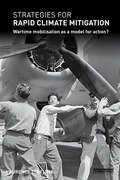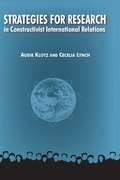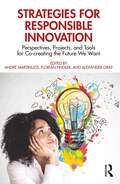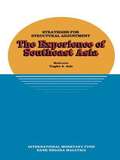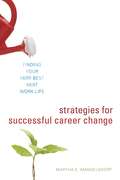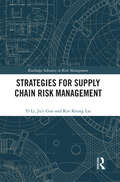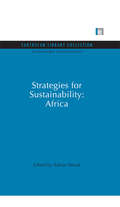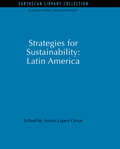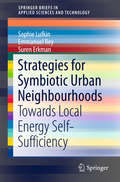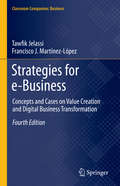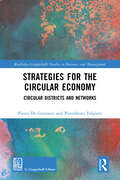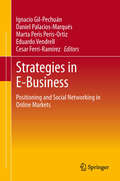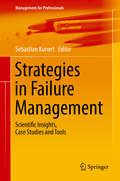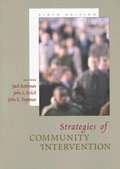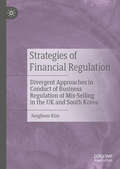- Table View
- List View
Strategies for Rapid Climate Mitigation: Wartime mobilisation as a model for action? (Routledge Advances in Climate Change Research)
by Laurence L DelinaTo keep the global average temperature from rising further than 2°C, emissions must peak soon and then fall steeply. This book examines how such rapid mitigation can proceed – in the scale and speed required for effective climate action – using an analogy provided by the mobilisation for a war that encompassed nations, the Second World War. Strategies for Rapid Climate Mitigation examines the wartime-climate analogy by drawing lessons from wartime mobilisations to develop contingency plans for a scenario where governments implement stringent mitigation programs as an ‘insurance policy’ where we pay for future benefits. Readers are provided a picture of how these programs could look, how they would work, what could trigger them, and the challenges in execution. The book analyses in detail one plausible approach to a crucial issue – an approach built upon knowledge of climate science and on proven and demonstrated mitigation measures. The book is meshed with a social and political analysis that draws upon narratives of mobilisations during the war to meet a transnational threat, while also addressing the shortcomings of the analogy and its strategies. The book will be of great interest to scholars, students, and practitioners of public policy, climate policy, energy policy, international relations, and strategic studies.
Strategies for Research in Constructivist International Relations (International Relations In A Constructed World Ser.)
by Audie Klotz Cecelia M. LynchConstructivism's basic premise - that individuals and groups are shaped by their world but can also change it - may seem intuitively true. Yet this process-oriented approach can be more difficult to apply than structural or rational choice frameworks. Based on their own experiences and exemplars from the IR literature, well-known authors Audie Klotz and Cecelia Lynch lay out concepts and tools for anyone seeking to apply the constructivist approach in research. Written in jargon-free prose and relevant across the social sciences, this book is essential for anyone trying to sort out appropriate methods for empirical research.
Strategies for Responsible Innovation: Perspectives, Projects, and Tools for Co-creating the Future We Want
by André Martinuzzi Alexander Graf Florian FindlerHow can responsible business work in the highly competitive areas of innovation? Focusing on business opportunities and illustrating how Responsible Innovation can be successfully implemented in practice, this book captures experiences and insights from key decision‑makers in business, politics, and academia, to answer this question. In addition to interviews with leading thinkers in the field, Strategies for Responsible Innovation describes the experiences of eight EU projects and provides tools for Responsible Innovation in the business sector.The examples in this book illustrate how to move from a vague societal aspiration to a business case for Responsible Innovation, and provide a compelling argument for collaboration at the important intersection between government, business, and academia. In this way, Responsible Innovation transcends a singular market-based approach to deliver value at many levels, co-creating in a truly inclusive manner. The book sheds light on the strategic benefits of applying the concept of Responsible Innovation in practice and offers concrete tools for its implementation.Aimed primarily at managers of innovation processes in organizations, and consultants and facilitators working on Responsible Innovation and sustainability management, the book also provides insight into the logic and principles of Responsible Innovation management for academics, policy-makers, and civil society organizations, helping them better communicate their requirements to business.
Strategies for Shaping Territorial Competitiveness (Routledge Studies in Global Competition)
by James R. Wilson Jesús M. ValdalisoThis book focuses on the main challenges that cities, regions and other territories at sub-national level face when it comes to designing and implementing a territorial strategy for economic development and competitiveness. There is a widespread recognition that territories need to construct strategies that focus on shaping sustainable competitive advantages. To do this they draw upon their own unique resources and capabilities alongside intelligence on existing technological and market trends. However, there is still a notorious lack of both theoretical and empirical research on this issue. The first part of this book develops a theoretical framework for understanding and analysing territorial strategy. This framework asks three questions of territorial strategy – what for, what, and how – looking closely at the key relationship between strategy and policy. The second part is dedicated to exploring this framework in practice through application to a series of unique cases from around the world at different territorial levels, from regions such as the Basque Country, Navarre and Murcia in Spain, Okanagan (British Columbia) in Canada, Wales in the United Kingdom, and the cross-border region of the Øresund in Denmark–Sweden, as well as the city of Rafaela in Argentina. Each case offers something different and enables the framework to be thoroughly tested, generating concluding reflections that add real value for scholars and policy-makers interested in and working in the field of territorial strategy. This volume is intended for the academic community, the policy community (government leaders, policy-makers, policy researchers and consultants) and university students and teachers at different levels interested in the areas of territorial competitiveness, regional development, competitiveness policies and processes of territorial strategy.
Strategies for Social Inquiry: Behind the Model
by Peter SpieglerThis ambitious book looks 'behind the model' to reveal how economists use formal models to generate insights into the economy. Drawing on recent work in the philosophy of science and economic methodology, the book presents a novel framework for understanding the logic of economic modeling. It also reveals the ways in which economic models can mislead rather than illuminate. Importantly, the book goes beyond purely negative critique, proposing a concrete program of methodological reform to better equip economists to detect potential mismatches between their models and the targets of their inquiry. Ranging across economics, philosophy, and social science methods, and drawing on a variety of examples, including the recent financial crisis, Behind the Model will be of interest to anyone who has wondered how economics works - and why it sometimes fails so spectacularly.
Strategies for Structural Adjustment: The Experience of Southeast Asia
by Ungku A. AzizA report from the International Monetary Fund.
Strategies for Successful Career Change: Finding Your Very Best Next Work Life
by Martha E. Mangelsdorf<p>Are you ready for a change? <p>Whether you’re seeking a more fulfilling job or rethinking your career goals after a layoff, the questions you face are crucial. In <i>Strategies for Successful Career Change</i>, seasoned business and career journalist Martha E. Mangelsdorf distills lessons from a diverse group of people who have made the leap and landed on their feet. To help you navigate the challenges, pitfalls, and rewards of career transition, this book will show you how to: <p> <li>Align your professional life with your personal goals <li>Identify your transferable skills, strengths, and constraints <li>Explore possible new careers in low-risk ways <li>Change careers while still paying the bills</li> <p> <p>You’ll assess your current work life and aspirations, while taking into account logistical realities such as finances, health insurance, and family obligations. Through exercises, resources, and inspiring stories from successful career-changers, this supportive and empowering guide will help you find your very best next work life. </p>
Strategies for Supply Chain Risk Management (Routledge Advances in Risk Management)
by Yi Li Kin Keung Lai Ju'e GuoExamining the negative consequences that arise from supply chain risks, this book systematically explores firms’ responses to these risks in different situations. In particular, it focuses on sourcing strategies of firms under supply chain risks and the different mitigation tools they use, such as supplier development and multisourcing. Supply chains have expanded extensively because many firms try to take advantage of outsourcing of their raw materials and critical components. Though firms can reap significant benefits due to the widespread use of outsourcing, they have to deal with increasing supply chain risks. In general, supply chain risks are various and may be originated from natural disasters, labor strikes, fires, and so on. These risk incidents can cause serious damage to firms’ profit performance. The analysis and insights from this book can be utilized by firms to alleviate the impact of supply chain risks in the sourcing process. It will also be of interest to researchers and students studying supply chain management.
Strategies for Sustainability: Africa (Sustainable Development Set #9)
by Adrian WoodThe World Conservation Union, Founded in 1948, brings together States government agencies and a diverse range of non-governmental organisations in a unique world partnership over 800 members in all, spread across some 136 countries. As a Union IUCN seeks to influence, encourage and assist societies throughout the world to conserve the integrity and diversity of nature and to ensure that any use of natural resources to equitable and ecological sustainable. The World Conservation Union builds on the strengths of its members, Networks and partners to enhance their capacity and to support global alliances to safeguard natural resources at local, regional and global levels. The Strategies For Sustainably Program of IUCN works to strengthen strategic planning, policy and implementation skills aimed at sustainability development at global, national and local levels. Working with networks of strategy practitioners from member governments, partner institutions and NGOs the programme assists in the conceptual development and analysis of experience of strategies, the development of a range of strategic planning and action planning skills and improved methods of assessing human and ecosystem well being. This volume, originally published in 1996, reviews more than a decadeof experience for sustainability in 12 African countries. These countries provide examples of very different approaches to strategy development and implementation. Many have been involved in the development of the National Environmental Action Plans (NEAPs) at the request of the World Bank. Other countries have developed their strategies independently, or have prepared National Conservation Strategies withe support from the IUCN.
Strategies for Sustainability: Asia (Sustainable Development Set #10)
by Jeremy Carew-ReidIUCN – The World Conservation Union Founded in 1948 The World Conservation Union brings together States, government agencies and a diverse' range of non-governmental organizations in a unique world partnership: over 800 members in all, spread across some 136 countries. As a Union, IUCN seeks to influence encourage and assist societies throughout the world to conserve the integrity and diversity of nature and to ensure that any use of natural resources is equitable and ecologically sustainable. The World Conservation Union builds on the strengths of its members, networks and partners to enhance their capacity and to support global alliances to safeguard natural resources at local, regional and global levels. The Strategies for Sustainability Programme The Strategies for Sustainability Programme of IUCN works to strengthen strategic planning, policy and implementation skills aimed at sustainable development at global, national and local levels. Working with Networks of strategy practitioners from member governments, partner institutions and NGOs, the Programme assists in the conceptual development and analysis of experience in strategies, the development of a range of strategic planning and action planning skills, and improved methods of assessing human and ecosystem well being. Originally published in 1996, the case studies in this volume were prepared by members of the IUCN/CESP Working Group of Strategies for Sustainability in Asia, including individuals who have been closely involved in the development and implementation of the strategies, and who are from the country concerned.
Strategies for Sustainability: Latin America (Sustainable Development Set #11)
by Arturo OrnatIUCN- The World Conservation Union Founded in 1948 The World Conservation Union brings together States government agencies and a diverse range of non-governmental organisations in a unique world partnership over 800 members in all, spread across some 136 countries. As a Union IUCN seeks to influence, encourage and assist societies throughout the world to conserve the integrity and diversity of nature and to ensure that any use of natural resources to equitable and ecological sustainable. The World Conservation Union builds on the strengths of its members, Networks and partners to enhance their capacity and to support global alliances to safeguard natural resources at local, regional and global levels. The Strategies For Sustainability Programme. The Strategies For Sustainably Program of IUCN works to strengthen strategic planning, policy and implementation skills aimed at sustainability development at global, national and local levels. Working with networks of strategy practitioners from member governments, partner institutions and NGOs the programme assists in the conceptual development and analysis of experience of strategies, the development of a range of strategic planning and action planning skills and improved methods of assessing human and ecosystem well being. Originally published in 1996
Strategies for Sustainable Air Services Development: An airline-destination collaborative approach (Routledge Studies in Transport Analysis)
by Chrystal Zhang Kareem YardeRoutes are arguably the most valuable of airline assets. Although widely practised in the industry, the process of developing air connectivity has drawn very limited academic research. However, this book fills in this knowledge gap.Strategies for Sustainable Air Services Development unwraps the process of decision-making in establishing airlinks from the airline’s perspective, as well as the roles of various stakeholders including airports, tourism authorities, tourist destination organizations, local investment agencies and regional development agencies. Developed from rigorous academic research and analysis of a myriad of data sources that include interviews, surveys and workshops with industry practitioners, it presents a framework of best practices that will serve as a "toolkit" and central resource point for industry professionals to initiate and establish airlinks to benefit air travellers and society at large.The first book of its kind, it presents the most comprehensive assessment available to date of all the intricacies involved in developing airlinks. The book will equip senior and middle managers, practitioners, policymakers and students with the practical skills and tools required to develop and design airlinks for the benefit of all stakeholders.
Strategies for Sustainable Financing of Secondary Education in Sub-Saharan Africa
by Keith M. LewinInvestment in secondary schooling in Sub-Saharan Africa has been neglected since the World Conference on Education for All at Jomtien. The World Education Forum at Dakar began to recognize the growing importance of post-primary schooling for development. Only 25 percent of school-age children attend secondary school in the region--and fewer complete successfully, having consequences for gender equity, poverty reduction, and economic growth. As universal primary schooling becomes a reality, demand for secondary schools is increasing rapidly. Gaps between the educational levels of the labor force in Sub-Saharan Africa and other regions remain large. Girls are more often excluded from secondary schools than boys. Secondary schooling costs are high to both governments and households. This study explores how access to secondary education can be increased. Radical reforms are needed in low-enrollment countries to make secondary schooling more affordable and to provide more access to the majority currently excluded. The report identifies the rationale for increasing access, reviews the status of secondary education in Sub-Saharan Africa, charts the growth needed in different countries to reach different levels of participation, identifies the financial constraints on growth, and discusses the reforms needed to make access affordable. It concludes with a road map of ways to increase the probability that more of Africa's children will experience secondary schooling.
Strategies for Sustainable Tourism at the Mogao Grottoes of Dunhuang, China
by Martha Demas Neville Agnew Jinshi FanAt the Mogao Grottoes, a World Heritage site near Dunhuang city in Gansu Province, visitor numbers have increased inexorably since 1979 when the site opened. A national policy that identifies tourism as a pillar industry, along with pressure from local authorities and businesses to encourage more tourism, threatens to lead to an unsustainable situation for management, an unsafe and uncomfortable experience for visitors and irreparable damage to the fragile art of the cave temples for which the site is famous. In the context of the comprehensive visitor management plan developed for the Mogao Grottoes, a multi-year study began in 2001 as a joint undertaking of the Dunhuang Academy and the Getty Conservation Institute to determine the impact of visitation on the painted caves and develop strategies for sustainable visitation such that, once implemented, these threats would be resolved. The methodological framework featured a major research and assessment component that integrates visitor studies; laboratory investigations; environmental monitoring; field testing and condition assessment to address the issues affecting the grottoes and visitors. Results from this component led to defining limiting conditions, which were the basis for establishing a visitor capacity policy for the grottoes and developing long-term monitoring and management tools.
Strategies for Symbiotic Urban Neighbourhoods
by Sophie Lufkin Emmanuel Rey Suren ErkmanUtilizing the results of a case study on the Gare-Lac sector in the city of Yverdon-les-Bains - the site is currently a large urban brownfield, intended to host ca. 3,800 additional inhabitants and 1,200 jobs upon completion - this work examines how to design attractive urban neighbourhoods that generate endogenous economic activity and foster socio-cultural dynamics, while moving towards local energy self-sufficiency. Exploring the different dimensions influencing energy self-sufficiency at the neighbourhood scale by integrating parameters related to buildings, infrastructure, mobility, food, goods and services, the work focuses on three scenarios (technological, behavioural and symbiotic) for the future development of this neighbourhood through 2035. The scenarios test different design strategies related to industrial symbioses, production, storage, transportation, and urban agriculture.
Strategies for Tapping the Groundswell: A Practical Approach to Developing Your Company's Social Media Strategy
by Charlene Li Josh BernoffYou know your business needs to get involved with social technologies, but the rapidly shifting landscape of social media is so confusing, you don't know where to start-you have "groundswell approach-avoidance syndrome." You're not alone. In this chapter, social media strategy leaders Charlene Li and Josh Bernoff identify the causes of groundswell approach-avoidance and suggest a treatment: clarify your objectives before you turn to the technology. You'll be introduced to the four-step POST planning process-people, objectives, strategy, and technology-that you should use to build your company's social media strategy. The authors then lay out the five primary objectives for groundswell strategy-listening, talking, energizing, supporting, and embracing-and show you how to pick the one that best matches the objectives of your company as a whole. This chapter was originally published as Chapter 4 of "Groundswell, Expanded and Revised Edition: Winning in a World Transformed by Social Technologies."
Strategies for a Sustainable and Environmentally Friendly Hospital Foodservice Management (Environmental Humanities: Transformation, Governance, Ethics, Law #6)
by Christian BuxSustainable catering aspires to reduce the environmental impacts of foodservice by serving nutritional, safe and environmentally friendly meals, and Italy has embraced the adoption of environmentally friendly diets and the minimization of food waste by introducing the minimum environmental criteria. However, there may be some tension between these two actions as environmentally friendly diets may lead to greater waste. The present book, in the field of the research projects entitled “Monitoring agri-food resilience and environmental savings in Puglia” and “Green supply chain management in the hospital catering service”, has the overarching purpose to improve the understanding of environmental, economic and social sustainability of foodservice, by considering the significant variables of energy efficiency, environmental impacts, waste management, customer satisfaction and user nutrition. The book reports the findings of different studies conducted in the hospital foodservice.
Strategies for e-Business: Concepts and Cases on Value Creation and Digital Business Transformation (Classroom Companion: Business)
by Francisco J. Martínez-López Tawfik JelassiThis is the fourth edition of a unique textbook that provides extensive coverage of the evolution, the current state, and the practice of e-business strategies. It provides a solid introduction to understanding e-business and e-commerce by combining fundamental concepts and application models with practice-based case studies. An ideal classroom companion for business schools, the authors use their extensive knowledge to show how corporate strategy can imbibe and thrive by adopting vibrant e-business frameworks with proper tools. Students will gain a thorough knowledge of developing electronic and mobile commerce strategies and the methods to deal with these issues and challenges.
Strategies for the Circular Economy: Circular Districts and Networks (Routledge-Giappichelli Studies in Business and Management)
by Pietro De Giovanni Pierroberto FolgieroThis book illustrates two approaches for firms to shape successful circular strategies, namely, the Circular Economy and Circular Districts. The former considers firms’ challenges when turning theoretical circular models into practice. Thus, it discusses the opportunities and difficulties in reshaping corporate strategies by reflecting on circular economy principles. The latter approach plays a new role within the new economy systems and this book conceptualizes and operationalizes its definition. The circular district can represent an effective way to accelerate the energy transition process by developing industrial collaborations and exploiting technology synergies to enhance circularity and achieve economic, environmental, and social targets. The book highlights how firms should adjust their strategic thinking, redesign their network of relationships, and reconsider the value creation process when the circular economy is a concrete option. Furthermore, it examines the evolution from circular economy to circular districts by revealing the motivations that push firms and supply chains to redesign their strategies by considering the perspective of a circular district. The book ends by analyzing business experiences in these two areas and proposes advancements for both the scientific community and the business world. The book offers a blend of theoretical frameworks and practical applications and will be of particular interest to scholars in the fields of sustainable operations, closed-loop supply chain, green supply chain management, and circular supply chains. Also, the operationalization of the concept of circular districts, offers a genuine and original theoretical contribution, thus targeting students from Executive programs, MBA programs, and PhD programs. The book will also attract managers, practitioners and professionals interested in real-world cases and experiences as well as practical developments in the domain.
Strategies in E-Business
by Ignacio Gil-Pechuán Daniel Palacios-Marqués Marta Peris Peris-Ortiz Eduardo Vendrell Cesar Ferri-RamirezIn this volume, the authors apply insights from a variety of perspectives to explore the alignment among strategy, organization design, process and human resource management, and e-business practices on developing successful social networking programs--with particular regard to applying such initiatives against the backdrop of the global financial crisis and challenges to traditional business models. Showcasing in-depth case studies, the authors present emerging approaches to analyze the impact of investment in social networking sites, aligning internal resources, and measuring effects on positioning, branding, and new business creation. The fact that a growing proportion of the world population has a relationship with social networking sites could prove very valuable for companies. The question is whether this represents a business opportunity, whether companies know how to make the most of it and if they will make the necessary efforts to adapt to these new platforms. In the modern world, social networking sites have enormous potential for large as well as small and medium-sized enterprises (SMEs); most companies are aware of the need for a presence on social networking sites, but at present their e-business strategies are part of their medium and long-term strategic planning and only a small percentage have been put into practice. In short, this book attempts to answer the following questions: Is there a business opportunity for companies on social networking sites? Do they know how to make the most of it? Are they willing to make the necessary effort to adapt? Can e-business strategies contribute to company creation and the success of already existing businesses? And if so, how?
Strategies in Failure Management: Scientific Insights, Case Studies and Tools (Management for Professionals)
by Sebastian KunertThis book offers a comprehensive overview of failure in business, management and consulting. It features contributions by experts from diverse fields, who share unique insights from their real-life experiences. Readers will find perspectives from leadership, project management, change management, innovation management, human resource management, counseling, restructuring, entrepreneurship and sports. Each chapter combines the latest empirical findings with relevant case studies, making for a unique book that offers a fascinating exploration of the largely unexplored area of setbacks, pitfalls, flops and disappointments in the business world.
Strategies in Global Competition: Selected Papers from the Prince Bertil Symposium at the Institute of International Business (Routledge Library Editions: International Business)
by Neil Hood Jan-Erik VahlneThe main thrust of Part 1 is to give some understanding of the concept of ‘global competition’. In doing so, the chapters rely heavily on industrial studies. Part 2 deals with two different aspects of this change viewed from two different perspectives. The one is economic and more macro: the other political and social and more micro, being concerned with the way in which companies have to utilize their various organisational units and integrate information on a fragmented environment into a strategic whole. Part 3 deals specifically with technology, as the particular segment of the environment which often has the largest impact on future strategies. In Part 4 the perspective of global competition is applied at industry, country and company levels and it is shown that this perspective adds new dimensions to old problems. The final parts address the problem of management in global competition.
Strategies in Sustainable Tourism, Economic Growth and Clean Energy
by Muhammad Shahbaz Daniel Balsalobre-Lorente Oana M. DrihaThis book provides an in-depth analysis of and discussion about the relationship between green tourism, economic growth and globalization. It explores numerous topics relating to tourism including transport efficiency, foreign direct investment, clean energy, climate change dynamics and advances in sustainable tourism management. The book begins with discussion of sustainable tourism and economic growth, particularly focusing on management strategies. It then presents the relationship between energy use and tourism, looking at green energy and energy shock. It then discusses transport efficiency, tourism efficiency and financial growth in both developed and developing countries. This book is of interest to researchers, policymakers, and postgraduate students in the areas of energy, environmental and tourism economics.
Strategies of Community Intervention (6th edition)
by Jack Rothman John L. Erlich John E. TropmanThis volume takes a broad view of community organization, viewing it as a rich and diverse field of practice that includes policy analysis and development, program planning, administration, evaluation, and resource development and allocation. The Sixth Edition emphasizes strategic and tactical considerations in community change. It treats social planning and policy initiatives, neighborhood-based citizen and empowerment approaches, and advocacy-oriented social action.
Strategies of Financial Regulation: Divergent Approaches in Conduct of Business Regulation of Mis-Selling in the UK and South Korea
by Junghoon KimThis book analyses different strategies and their results in implementing financial regulation in terms of rule-making, public enforcement and private enforcement. The analysis is based on a comparative study of conduct of business regulation on mis-selling of financial instruments in the UK and South Korea. It extends into liquidity regulation in the banking sector and credit rating agency regulation. The book concludes that in rule-making, purposive rules are more effective for achieving regulatory goals with minimal undesirable results, but a rule-making system with purposive rules can only work on a foundation of trust among rule-makers, enforcers and the regulates, that with respect to public enforcement, the enforcement strategies should combine the compliance-oriented and deterrence-oriented approaches and be continuously adjusted based on close monitoring of the regulatory outcomes and that in private enforcement, regulation should be instituted as the minimum requirement in private law.
